(Note: Most of this blog entry was written by Rick – that will become obvious when the technical aspects of the trailer improvements are detailed. Cindy added a bit and posted it. Enjoy!)
WE BOUGHT A TRUCK AND TRAVEL TRAILER!
The truck and trailer was a purchase we had not planned to make at this time because things are so in flux with our SV Cool Change, which is currently decommissioned and awaiting our eventual return to the Kingdom of Tonga to continue our voyage to Australia. But that is another story…
We have long planned on a USA tour in an RV as a future retirement adventure, and now it is becoming a reality. Once we realized that Tonga was likely not going to open its borders in 2021 due to Covid 19, we set our sights at exploring the US instead, visiting family and friends from Washington State to Washington DC and beyond. We plan on departing June 19 and returning home with the rig in December, with a little hiatus in the fall.
Traveling in an RV has several similarities to traveling in a sailing yacht but without the long open ocean passages, fears of dragging anchor, hitting a reef and/or sinking! Still, there are similarities in the onboard systems in that both have a pressurized potable water system, a hot water heater, battery charging systems, a shower, and a toilet. Both also have some kind of shade device to allow a person to get out of the sun and elements.
We bought a 29 foot, 2011 travel trailer from our good friends Wig and Laura at a very reasonable price. They knew we were planning an RV adventure and they were done with theirs after having the trailer for about eight years, so they made us an offer and we decided to go for it. They were meticulous about keeping the trailer looking brand new, so the trailer we got from them sparkled! It was definitely not as large or fancy as the fifth wheel we had envisioned, but for about one seventh of the price, we could do without recliners and a fireplace! Otherwise, it had all of our must-haves such as being able to get out of the bed on either side, an upgraded mattress, and kitchen food prep counter space. The refrigerator is sizable, the air conditioning is powerful, and the storage space is abundant in comparison to Cool Change.
From lots of exploration on the subject, we decided we needed a 3/4 ton diesel truck to safely pull the trailer, so we started searching for one. Our criteria for the search was that we wanted a Dodge Ram 4WD Laramie package with less than 100k miles, a clean carfax and preferably one owner, at a price we could afford.
Cindy took the lead on the search, which ended up being nationwide as we were finding nothing in California. After a couple of months of looking and many failed leads, Cindy found a great truck in Utah. I flew out to Salt Lake City and the dealer was kind enough to pick me up at the airport and bring me to the dealership where the truck was waiting, and I drove it home. The whole trip took less than two days.
TRAILER IMPROVEMENTS
As we are planning to be traveling & living full time in this RV for at least six months on our first trip, we knew we would need to make some improvements to some of its systems. The most serious issue came from a prior leak that had since been fixed: the cargo area floor was destroyed and needed to be replaced. That was a sizable effort. Also, the house battery bank needed replacement. There was an issue with the fresh water pump that I (Rick – from now on in this post, “I” is Rick) was able to fix just by taking it apart and freeing the diaphragm that had been calcified from sitting dry for a long period of time.
The new house battery bank we installed consists of two deep cell lead acid golf cart batteries that are connected in series to give us 230ah at 12v. I figure the house bank capacity is minimal for what we will be doing so it will need an adequate intelligent charging system to keep the batteries in good health. I installed a battery monitor system for the same reason, as well as to help learn about what our daily electrical usage will be, and what will be required to keep up with the demand.
The trailer has a 13.5k BTU air conditioning unit, which will be crucial to comfort while we are living in it. It is powered off of the shore power when we are in a place that has hookups but as we often won’t have that luxury, we needed to purchase a suitable generator to provide power when we are “dry camping”. After some research we decided on purchasing a Generac 3500 Inverter generator. It is capable of providing 3500 watts. We will need at least that much power to handle the starting and running loads of the AC unit, not to mention the additional loads of the microwave, water heater and various accessory loads. The only drawback to the generator is its weight. It is 100 lbs! Because of weight considerations, people often use two smaller generators they can parallel for an output equal or better to what we will see from our single unit. The advantages of our system are that it was cheaper than two smaller ones, it will be harder to steal, and I won’t have to maintain two separate units!
Our plan is to leave the generator in the bed of the truck and run it from there whenever possible. There will be times when that plan will not work, though. Knowing this, we considered mounting a mini crane system in the bed of the truck that I could use to hoist the generator in or out of the truck. However, the infrastructure needed to support the crane turned out to be too extensive to make it feasible to accomplish in the short window we had before we set out on our journey.
Because most of our portable electronics require USB charging, I installed six USB charge ports. There are three ports on each hub installed on either side of the bed, and I will probably install a couple more in the galley area. We hope to be installing some type of inverter at some point to give us AC power from the battery bank. We need to really consider the size inverter to install based on anticipated needs and battery capacity. I expect it will be about 1500 watts. Most of what we would be using that power for would be the TV, computers and the microwave.
The battery monitor installation involved running cabling from the batteries at the front of the trailer to the far end where the monitor display is located next to the power distribution panel. It called for installation of a 350 amp shunt on the negative battery return as close as possible to the battery bank. I found a spot to locate it under the chassis where I could mount it in a waterproof junction box. In the same area I installed an accessory fuse box capable of handling six accessory circuits. The USB outlets are connected to two of the circuits and fused @ 10 amps.
I replaced a corroded, rather feeble original main fuse with a 60 amp ANL fuse in a nice Blue Sea fuse holder. I replaced the battery cables running between the ANL and the positive bank as well as the ones from the new shunt to the negative side.
The contact point from the negative battery terminal to the frame was seriously corroded so I cleaned that up and used fresh hardware to make a solid frame connection.
I am as yet undecided about whether I need to replace the inboard charger/inverter. What I have noticed is that it takes a long time to charge the house batteries. I had not seen more that about eight amps coming out of it when charging the house bank. But on our shakedown, we ran the batteries down to 80%, and for a time I saw 17 amps being delivered to the batteries while running off the generator. Still not great but maybe usable for a time. This will probably be something that I will replace during our travels.
On our US tour, we plan on spending a lot of time on the road. Some RV’rs move slowly from place to place and stay the maximum amount of time in each location; that is not our plan. Instead, we will be visiting family in so many places in such a tight time frame that we will usually be spending only a few nights in each location. Driving so frequently provides a good opportunity to use the truck to charge the trailer batteries. Though there is a charging link through the seven-pin receptacle on the truck hitch, it is not wired for any high loads. It amounts to not much more than a trickle charge being delivered to the house bank in the trailer when on the road, so it was obvious that we needed a better solution.
We installed a 40 amp DC to DC charging system, which is powered off the truck’s 160 amp alternator. It involved running 4 gauge wires and a fuse block that starts at the trucks primary battery, runs through the engine compartment to the undercarriage, and eventually to a connector installed close to, but independent of, the existing electrical connection between the truck and trailer. From there, it connects to another 4 gauge circuit to the charging unit, which is located on a wall in the cargo bay. Because the unit will generate a lot of heat and needs airflow, we needed to install something to isolate the unit from being smothered or touched by the items we will be carrying in the cargo bay. Cindy found a metal wire food basket on Amazon that I was able to convert to serve as a cage for this purpose and it should work great. The charging unit is capable of delivering a 40 amp charge current while we are on the road traveling between sites, and it uses a smart programmable 3 stage charge controller to meter the current and voltage output according to the state of charge on the batteries. Theoretically this will insure that when we get to our destinations, we will arrive with a fully charged house bank.
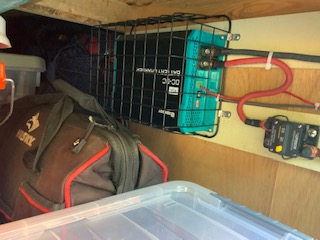
The DC to DC charger 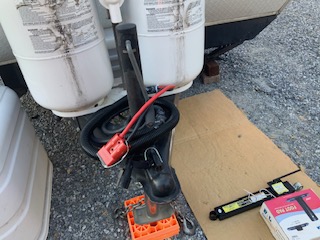
Trailer connection for the DC charger 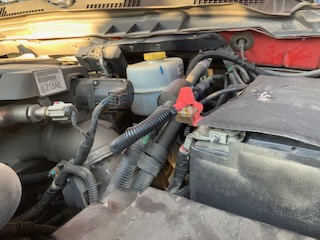
Engine compartment wiring for the DC charger
My only complaint is that the company we bought the charging system from, Renogy, is very short on providing any support for their products. I found that with the charge profile I set up using their installation manual, the output voltages for absorption and float voltage are both incorrect. I believe there is an error in the manual and I have made several attempts to contact them to discuss it but to no avail. For this reason I would not recommended purchasing this product. With the current issue or any new issue I will likely not be able to count on getting any manufacturer’s support.
We had the trailer tires checked out. Apparently they are in good shape and of sufficient quality to handle our long distance travel plan and the loaded weight of the trailer. Wig had told us he had trouble with his first set of tires, had a couple of blowouts and then had replaced all of the tires not that long ago. Still, one of the big vulnerabilities with a trailer are the tires. The issues, aside from having quality tires, are to ensure before each move that the tire pressure is correct. If not, you risk overheating the tires and having a blowout. So I (Rick) found a good quality portable air compressor that operates off of 12 volts and has enough power to inflate the tires to the higher pressure. I installed a wireless tire monitoring system that transmits to a monitor in the truck so I can see current stats for tire pressure and temperature of all the tires while we are on the move. The whole idea here is just to minimize conditions for a blowout that could prove catastrophic. This would be roughly equivalent to dragging anchor in Cool Change in the direction of a reef!
Along with the tire safety, a big concern while underway is sway. This can occur as a result of too much speed, or wind or pressure variations caused by semi-trucks passing nearby. We purchased and installed an antisway bar onto the trailer to help to mitigate any sway issues. The trailer came with a weight distribution hitch, which also avoids sway by balancing the weight of the trailer so that the front tires of the truck are carrying close to equal weight of the rear wheels. This system seems to work pretty well as I have measured the height of the front wheel well when the truck is carrying the trailer load vs when it is not.
Aside from the mechanical and electrical improvements, Cindy has been making the inside of the trailer homey and comfy, and has sewn a number of items we needed for the trailer. We purchased a spare tire mount for the rear bumper because we didn’t like taking up space in our pass-through cargo compartment for the spare tire. So Cindy made a spare tire cover to keep it out of the sun. She also sewed a cover for the generator to protect it somewhat from the heat and hopefully, to make it look less obvious to thieves. (We have the generator chained and locked in the truck bed but you never know). Also, we noticed that light came through the bedroom overhead hatch so she made a cover for that. We decided we would bring our large ice chest and keep it in the truck bed while traveling and have it double as a footstool/coffee table when we are relaxing outside under the awning, so Cindy made a cushioned cover for the top of the cooler.
We purchased a surge protector to use when we are connected to any commercial power to protect the electrical system. This is a must-have item if you are going to be connecting to power anywhere! Along with the surge protector, we bought a water pressure regulator to connect to the trailer’s water inlet when we are using pressurized city water. The water lines in a trailer can easily be blown out if the pressure from a city water source is too high. The pressure regulator, at about 15 dollars, amounts to some very cheap insurance. We also bought an inexpensive in-line water filter to minimize sediment accumulating in the fresh water tank.
One night while the trailer was parked at home and plugged in to the electrical outlet Rick had installed, we decided to watch a movie on the trailer TV. We soon realized that the TV speaker was inadequate. We stopped the movie and started searching throughout the house and the barn for some way to amplify the sound. Nothing seemed to work – our Bluetooth speaker had no way to receive input by cable, and other spare speakers we had didn’t have the proper connections either. Finally, it occurred to us that the trailer actually has an fairly nice stereo sound system throughout, and the controls were not too far from the TV. Rick temporarily rigged up a cable with both ends having the proper connection for the TV output and the stereo input. We plugged it in, turned on the TV and DVD, and voila! we were practically blasted out of the trailer with an incredibly loud, much improved stereo sound! Rick has since made the cable installation a little more permanent.
Now we need to consider whether it would be worth it to have an inverter that would allow us to watch a movie without being plugged into power or the generator. We have about a half dozen old movies on DVD and thousands of them on a USB drive that was loaded for is by a friend in Puerto Vallarta. The movies are all from 2016 or earlier. We may find other things to do with our evenings while we travel but we have become so accustomed to a little movie entertainment at home in the evenings, that it would be nice to continue that custom.
In addition to the floor of the cargo compartment, another obvious maintenance issue with the trailer when we bought it was the condition of the awning. While it still worked, it was duct-taped near the roller, and one of the two brackets that held the bottom of the awning onto the trailer was broken. We considered using the awning until it completely fell apart, but we decided that could happen while moving, which could be disastrous. Replacing the broken bracket would have bought us some time, but after calling all around, consulting with experts, and ordering three different brackets online that didn’t fit, we realized that the complete absence anywhere of a no-longer-manufactured, $5 part was going to cost us $1500 to install a new awning. That was ok, though. The awning installed on our 2011 trailer was only manufactured for a couple of years because it was a failed design, and replacing it would save us grief in the long run. So, we headed over to a wonderful little, family-owned RV repair shop a few towns away and got it replaced in one day.
THE SHAKEDOWN CRUISE
After a month or so of working on repairs and improvements to our trailer, we decided to test our systems and become more familiar with the trailer workings by camping for a few days. We were able to secure an unimproved spot for three nights at Beals Point Campground on Folsom Lake just east of the City of Folsom, California, about a 45 minute drive from our house.
Part of the shakedown involved testing whether Rick had cut away enough of the embankment on the private road we live on, to get the trailer out safely. The road is narrow, one-lane, dead-end and gravel, with a very sharp turn on our way out, just after leaving our house. Fortunately, we had at least a foot to spare as Cindy guided Rick from the road to get around the turn. The next challenge was to turn from our road onto a major arterial road called Marshall Road. The section of Marshall Road here is at a fairly blind curve right before where our road connects with it. Rick has frightening memories of teaching our kids to drive and how to safely get onto Marshall Road. He had been nervous about getting out of our property and onto the main road while pulling the trailer, fearing the worst as the week leading up to our departure approached. He even started pulling out from our road onto Marshall more slowly in our car, just to get used to relaxing through the turn. It really helped that a neighbor had installed a mirror that helped us see any traffic coming from up around the turn. When we finally pulled out with the trailer, all went well.
When we got to the campground, it took us about an hour to get all set up, leveled and ready to relax. We were staying for three days, giving us ample time to get used to things.
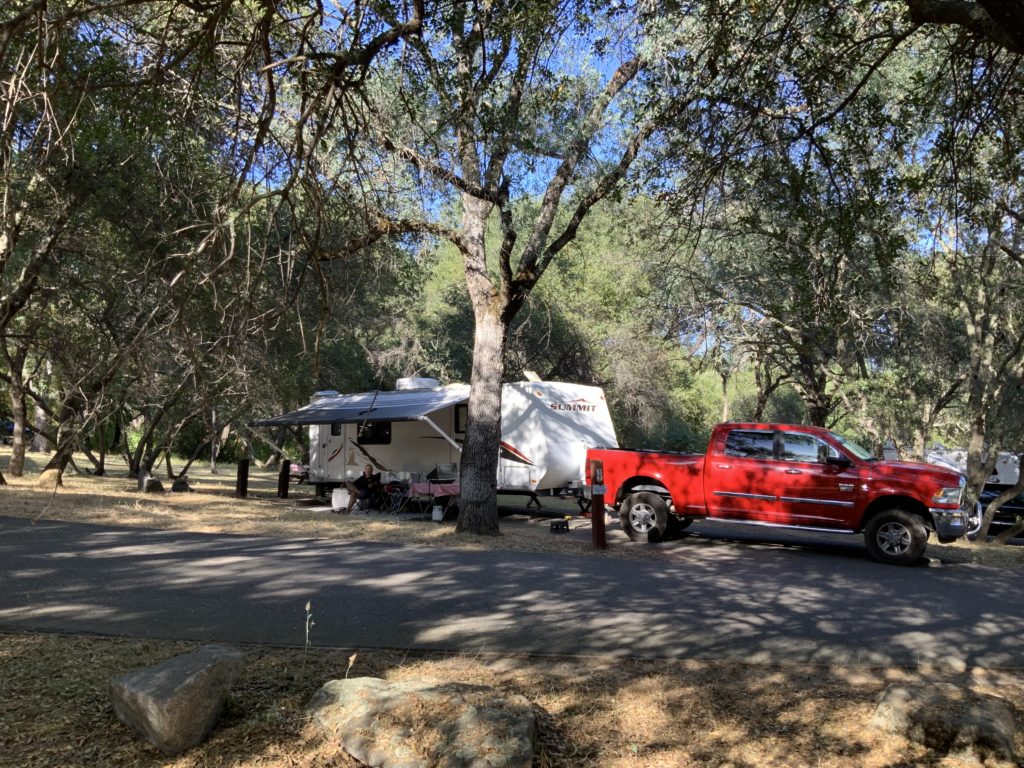
This trip definitely gave us a perspective of different types of people we will likely encounter on our trip. There was a trailer next to us with three adults and five small dogs. It appeared that they were likely down on luck and were living long term in their trailer, which was pretty dilapidated. From the sounds that we could not help but hear emanating from their trailer, we came to the conclusion that they were probably smoking a lot of crack or at least something that was making one of them cough and hack loudly, but only intermittently.
All three mornings we took an hour or longer walk through the campground, out to Folsom Lake, and through the woods. We hope to be able to continue our daily walks throughout our travels. In the afternoon of the first full day, Cindy’s sister Sharon came by to visit for a few hours. She liked the spot and was surprised how convenient it was to where we all live while at the same time feeling far away from the hustle and bustle.
The second night we were there, I (Rick) was doing some cooking outside and a guy was walking by who had set up camp a couple spaces down from us. He was completely shit-faced drunk/high and he wanted to chat. He was not making a lot of sense and I was doing my best not to encourage him. He casually mentioned that he was waiting for a friend to arrive and that they would be doing some partying but should not be too loud. Then he said goodnight and sort of stumbled on his way.
The space between him and us had been unoccupied up to that time but sometime during the night, someone showed up and set up a trailer in the space. We awoke late at night to some loud voices, music and what seemed like a large group of revelers. It began and went on way past “quiet time.”
The next day after they had slept late and were finally up and about (and sober), we went over to the couple that was now next to us and let them know that we were not happy about being kept awake late into the night by them partying and asked if they were they planning on more of the same tonight? It was a young couple and they were obviously embarrassed at being called out on their behavior. They said that they had arrived at the campsite late that night. They said that the folks in the site next to them, (aka the drunk guy) whom they had never met, came over and just invited themselves to be with them and ended up staying much longer than expected. They apologized and said it would not happen again. So anyway, I am thinking this will just be a part of what we will have to deal with on our travels, but that it is all just a part of the experience.
On our last night camping, Rick’s sister Linda and husband Rich came by along with our niece and nephew, Jennifer and Mike. We had a great visit and a dinner of tacos with all the trimmings. It was a really nice way to end out our first RV adventure.
We learned a few things about the trailer on this trip. One was that we were glad we had the generator because it was too hot not to run the air conditioner. Also, we were glad we had an extension for our power chord from the generator to the trailer; otherwise, the chord would not have been long enough for the the generator to power the trailer when the truck is parked in front of it. Another thing we confirmed was that our DC to DC charger from the truck would be essential to insure that our batteries become fully charged during the process of traveling between locations. While monitoring power usage during this trip, we realized how much power was being wasted by the use of incandescent bulbs; we followed up by replacing them all with LED’s. And speaking of power usage monitoring, we confirmed how much more accurate the battery monitor that Rick installed was, compared to the stock battery monitor that came with the trailer. Rick called it “a toy.”
It was on this trip that we decided, after getting a good look at the awning, that we needed to replace it. It still worked, and we realized how essential it was for enjoying sitting outdoors, but it was definitely on its last legs. When our visitors arrived and we gave them our spare chairs to use, we realized that those inexpensive collapsible chairs weren’t suited for long term sitting; comfortable camp chairs are critical. Inside the trailer sleeping at night, we thought a fan in the bedroom like the ones we had in the boat would be nice, since rarely could we run the generator while sleeping. Rick followed up by installing a fan. Finally, Cindy was relieved that most of the cooking could be done on the little Coleman stove we had outside on a table; it was just too hot to cook inside. That stove is powered by a separate, 2.5 gallon propane tank that we carry with us.
The next morning we went through a two-hour process to get the trailer ready to go and visit the dump station, where we dumped out black and grey tanks (thankfully without incident). We made our way back home.
PREPARING TO LEAVE
Preparing to leave on a six month voyage throughout the United States, interrupted by a likely airline flight home for a month or so in the middle, is enormously easier than planning a sea voyage to another country or across oceans. Most obviously, almost anything we forget, we can buy along the way, unlike when you are in open ocean or even near shore but in a foreign land. Nevertheless, there is a lot of planning involved.
First, contrary to our preferred travel style, we have to plan where to stay each night and make reservations, especially during a summer when everyone is bursting out of their Covid cocoons by taking to the open road, so many of the campgrounds are booked. We really prefer to just see where the road takes us, spend as long as we are enjoying ourselves there, and go next to where the wind blows, so to speak. But that scenario is just not in the cards for this trip. We are going to visit family and friends, and they all have busy lives, so just coordinating our visits with their schedules is quite the challenge. And then there is the matter of where to put the travel trailer while we are visiting them or otherwise sightseeing along the way. Most of our family members, as it turns out, are living in fairly urban environments, and the few who are rural still don’t have good access to their house for a trailer, with just a couple of exceptions. (We understand that because even in our case, we had to make some minor road improvements to our own rural, private road just to get our trailer around the tight corners). It is ok for us to stay in a random parking lot that allows overnight parking, such as some Walmart’s, if we are just going to pull over and stay put. But if we want to unhook the truck from the trailer to explore or visit people in places where a 29 foot trailer wouldn’t fit, we need a safe, flat location to leave the trailer. And if it is not convenient for us to stay overnight with those we visit, we need to be able to set up the trailer to stay in it.
So far, our six-month itinerary has 60 stops, we have paid for advance reservations at 11 different locations, and we have made arrangements for six additional places to stay. Some of the remaining stops will just be overnighters in a random parking lot, but many will require reservations that we just haven’t had time to make yet! Besides, it is really hard making reservations when you know very well that RV travel can be unpredictable, delays due to weather or maintenance issues are almost inevitable, and cancellations generally have a fee if the reservations are even refundable at all.
Cindy is making most of the reservations and has started from the beginning, day one, and is considering possibilities chronologically from there, with a few exceptions. The whole first six weeks or so are centered around arriving at Midwest relatives’ abodes at the right time – a high school graduation party here, a window between other commitments there, etc. Backing up from there, on the way we will be visiting our daughter in Portland and our sons in Washington, who also have very busy schedules, seeing Glacier National Park and Yellowstone, and catching a few riverside or oceanside campgrounds along the way. After Nebraska, Minnesota, Illinois and Missouri, all family locations, we will be heading to see a cousin in Tennessee before arriving at a nephew’s in New York State and then over to Rick’s sister’s house in New Hampshire. From there we will do some touring of the Northeast, spend Labor Day with an old college friend of Cindy’s, and then fly back to California by mid September for a month or so, leaving the entire rig at Rick’s sister’s house, thank goodness. The only reservation we have made after that is in the Florida Keys in November, and only because Florida in the wintertime is notorious for being a difficult location to secure camping reservations.
A friend recently asked me (Rick) why we are calling this trip the “Land Yacht” voyage when he is calling a planned trip to the Russian River a few hours from his home in their newly purchased motor home a camping trip. I can only hope after reading this post that he gains an understanding of the differences between both the vehicle preparations needed and the concept of planning and circumnavigating the US over a six month timespan versus taking a three hour drive to the Russian River and spending a week in a campground. :). Voyage of the Land Yacht begins tomorrow!
So, wish us luck. We leave Saturday June 19. Below is a tentative map of our itinerary. We hope to continue to post frequent updates here as we travel.

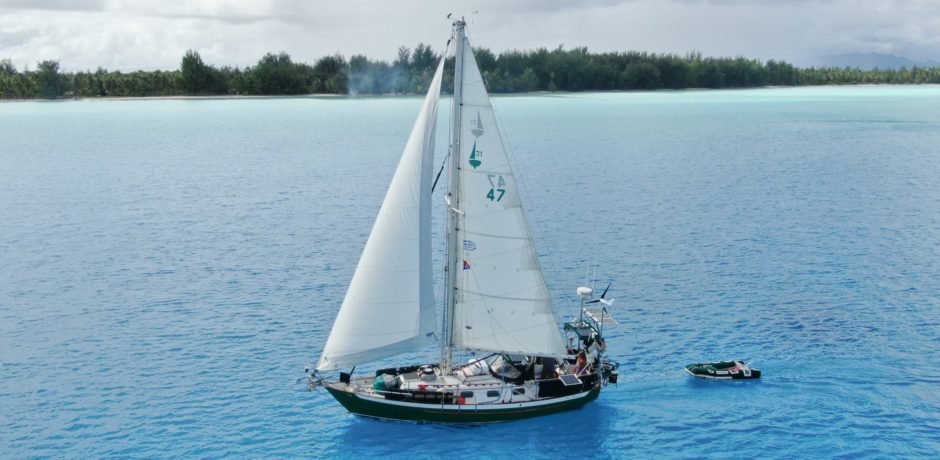
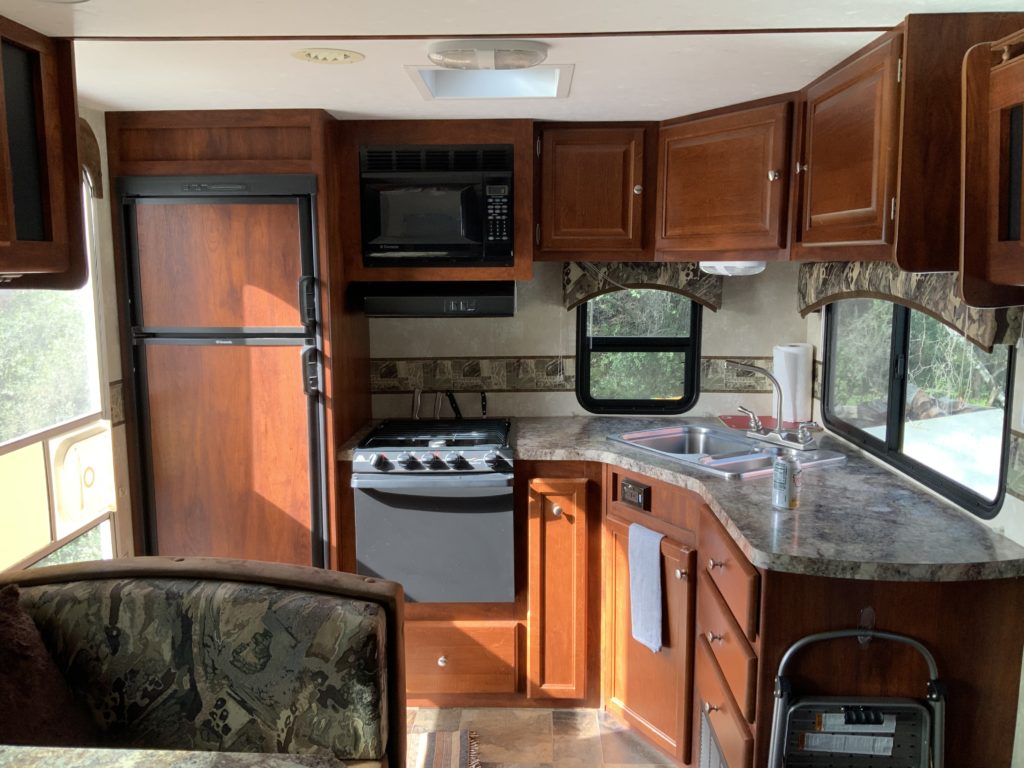

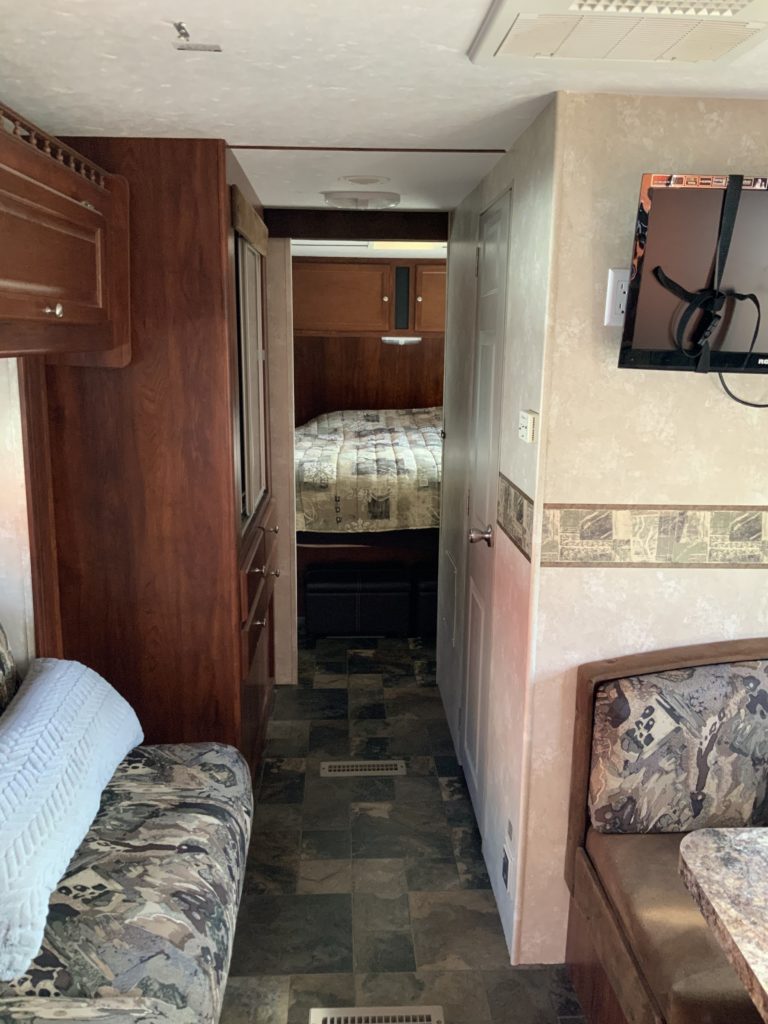

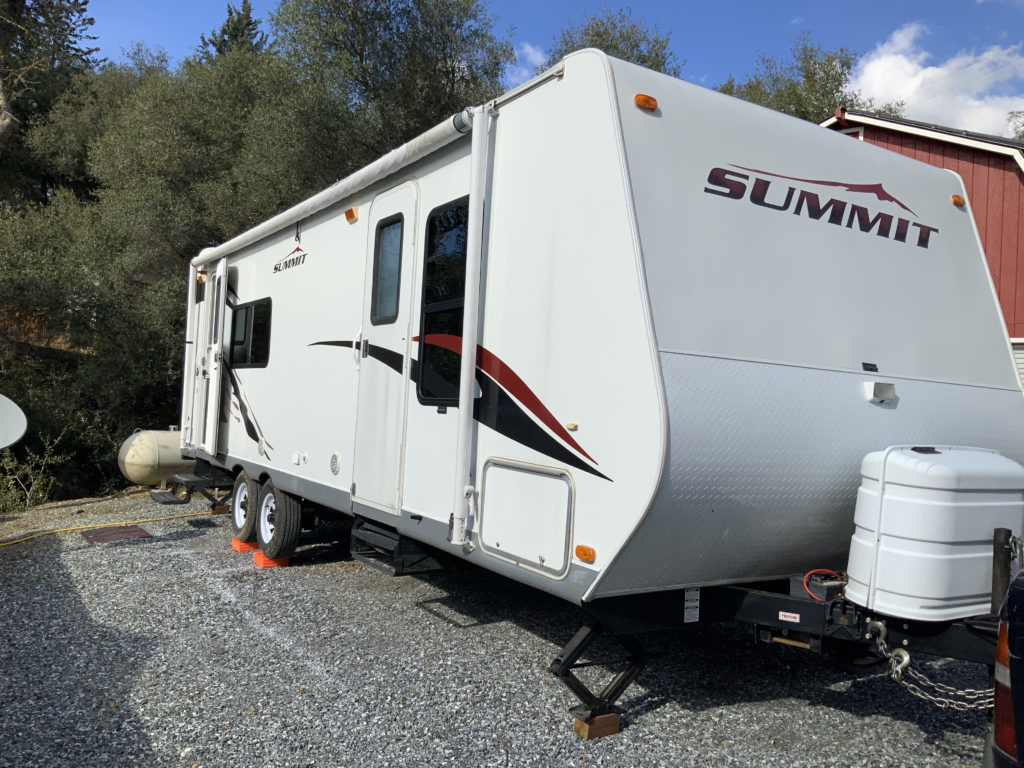

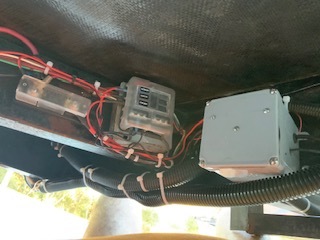
Crack heads, loud parties, drunken teenagers, quite a different setting from the warm friendly smiles and turquoise waters of the Tuamotus. You mentioned in an earlier blog you might ship Cool Change back to the US from Australia, is this no longer an option? Perhaps to Florida and spend your winters cruising up and down the Exumas? or the ICW?
Probably not. At this point we just want to get to her, make sure she is seaworthy, and get her out of Tonga!